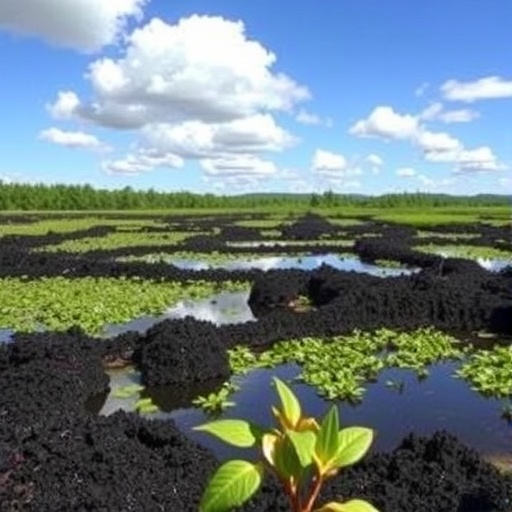Restoring Degraded Agricultural Peatlands: A Synergistic Approach to Mitigating Climate Change Through Rewetting, Biochar, and Iron Sulphate Amendments
Peatlands represent some of the most critical terrestrial ecosystems for carbon sequestration, storing more carbon than the combined biomass of the world’s forests despite covering less than three percent of the Earth’s land surface. However, extensive drainage for agricultural purposes has dramatically altered many peatlands, transforming them from carbon sinks into significant sources of greenhouse gas emissions. This alarming shift exacerbates climate change challenges by accelerating carbon loss and increasing methane emissions. In response, scientists have been exploring innovative methods to restore peatland functionality and revive their capacity to act as long-term carbon repositories.
A groundbreaking experimental study spearheaded by researchers at Bangor University and the UK Centre for Ecology and Hydrology has provided new insights into how integrated soil management strategies can effectively reverse peatland degradation. The research focused on the combined application of rewetting, the addition of biochar derived from Miscanthus—a high-yield perennial grass—and small doses of iron sulphate to optimize microbial activity and carbon stabilization within drained agricultural peat soils. This multifaceted approach was tested over a year-long outdoor mesocosm study that simulated real-world peatland conditions, providing a robust framework to understand the nuanced interactions between biogeochemical processes and soil amendments.
Rewetting alone, the elevation of the water table to maintain saturated soil conditions, is widely acknowledged as an essential peatland restoration technique. By reinstating anaerobic conditions, rewetting slows down the aerobic microbial decomposition of organic matter, thereby curbing carbon dioxide emissions. However, the process holds the inherent risk of increased methane generation, a potent greenhouse gas produced by methanogenic archaea thriving under anoxic conditions. The innovative aspect of this study lies in its demonstration that coupling rewetting with biochar and iron sulphate amendments can mitigate this methane emission trade-off while enhancing carbon retention.
Biochar acts as a stable, carbon-rich soil amendment, produced through pyrolysis under oxygen-limited environments. Its unique porous structure not only contributes refractory carbon to the soil matrix but also creates microhabitats that modify microbial ecosystems and alter nutrient cycling dynamics. In the peatland context, the introduction of Miscanthus biochar was shown to suppress the activity of critical soil enzymes responsible for organic matter decomposition, effectively reducing the acceleration of carbon release via microbial respiration. This action crucially supports the permanence of carbon sequestered within the soil system.
Iron sulphate addition plays a complementary role by leveraging the mineralogical capacity of iron to bind with organic compounds—a phenomenon colloquially termed the “iron gate” effect. Through the formation of iron-organic complexes, iron sulphate promotes the stabilization of soil organic matter, minimizing its bioavailability and subsequent microbial degradation. This mineral-mediated protection translates to increased resistance of soil carbon to decay pathways. Furthermore, the iron amendments suppressed populations of methane-producing microbes, curtailing methane emissions associated with rewetting-induced anoxia.
The synergistic interaction between rewetting, biochar, and iron sulphate creates a soil environment where microbial hotspots—the zones of intense biochemical activity—are modulated to favor carbon preservation over decomposition. The study’s measurements revealed significant reductions in enzyme activities such as cellulase and phenol oxidase, which catalyze the breakdown of complex organic polymers. Simultaneously, methane flux monitoring indicated a notable decrement in gaseous emissions when iron sulphate was included alongside biochar in rewetted soils, suggesting a dual mitigation pathway for climate-relevant greenhouse gases.
This research underscores the critical importance of considering soil microbial ecology and geochemical interactions when devising restoration strategies. Rather than relying solely on hydrological manipulation through rewetting, integrating biochar and iron amendments provides a multi-pronged approach to reinstate peatland carbon sinks effectively. Such interventions have the potential to disrupt the positive feedback loops often seen in degraded peatlands, where increased decomposition feeds back into warming and further carbon release.
Diagrammatically, this restoration paradigm shifts the peatland system back towards a balanced carbon budget, tempering microbial decomposition while preventing the emergence of alternative greenhouse gas pathways. It is a prime example of how advances in soil science and environmental chemistry can inform practical, scalable ecological restoration techniques. The results demonstrate that the biological and chemical complexity of peatlands, often viewed as a challenge, can be harnessed through targeted interventions to promote climate resilience.
From a global perspective, restoring the carbon storage capacity of peatlands is indispensable for meeting climate mitigation targets. The approach detailed in this study offers a replicable model adaptable to various agricultural peatlands worldwide, particularly those impacted by centuries of drainage. Its implications extend beyond carbon management, potentially enhancing soil health, agricultural productivity, and biodiversity conservation through improved hydrological function and soil chemistry.
The success of this multi-element strategy highlights the need for interdisciplinary collaboration in addressing environmental challenges. It bridges the gap between ecosystem ecology, soil microbiology, and applied soil chemistry, revealing pathways to reconcile agricultural land use with carbon conservation goals. Such integrative research paves the way for policies that incentivize peatland restoration management practices capable of delivering measurable climate benefits.
In conclusion, while rewetting remains the cornerstone of peatland rehabilitation, its integration with biochar and iron sulphate amendments emerges as a promising frontier in environmental restoration science. This synergistic treatment regime not only enhances carbon stabilization but concurrently mitigates methane emissions, addressing two sides of the greenhouse gas equation. As researchers continue to unravel the complexities of soil microbial processes and mineral interactions, such holistic approaches will be vital in reversing peatland degradation and advancing global climate action.
Subject of Research: Not applicable
Article Title: Restoring degraded agricultural peatlands: how rewetting, biochar, and iron sulphate synergistically modify microbial hotspots and carbon storage
News Publication Date: 10-Sep-2025
Web References: http://dx.doi.org/10.1007/s42773-025-00501-y
References: Jeewani, P.H., Brown, R.W., Rhymes, J.M. et al. Restoring degraded agricultural peatlands: how rewetting, biochar, and iron sulphate synergistically modify microbial hotspots and carbon storage. Biochar 7, 108 (2025).
Image Credits: Peduruhewa H. Jeewani, Robert W. Brown, Jennifer M. Rhymes, Chris D. Evans, Dave R. Chadwick & Davey L. Jones
Keywords: Soil chemistry, Environmental chemistry, Soil science




